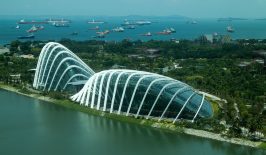The effects of climate change have long been visible and tangible across the globe. In Europe too, weather changes caused by climate change are becoming increasingly frequent, such as flash flooding due to rainfall and heatwaves in summer. This not only puts a strain on people’s health, but also on infrastructure, nature and our ecosystems. What might a solution look like in which natural resources are used to help cities adapt to these kinds of extreme weather conditions?
Field Factors, a Dutch company specialising in the development of water treatment solutions for urban areas, has developed a biofilter system called Bluebloqs that stores and filters rainwater to be reused in drought periods. In this way, urban wastewater systems can be relieved during heavy rainfall events and large areas of private or public space can be cooled during hotter months. “We’ve seen that green solutions are much better at draining excess water during periods of heavy rainfall,” explains Wilrik Kok, who is responsible for partner and business relations at Field Factors.
Capture, Filter, Store, Reuse
The system captures excess water that runs off streets and other surfaces during periods of heavy rainfall. The collected rainwater then flows through a biofilter, including a sand filter and a natural plant-based purification system which filters heavy metals and organic pollutants out of the water. Both the sand filter and the reed bed treatment plant do not use any synthetic chemicals at all – relying instead on the innate filter functions of these natural materials.
After filtration, the water is stored underground in so-called infiltration wells. Overall, according to Field Factors, the Bluebloqs system can store up to 95 percent of the rainwater collected after filtering, so that it can be used again in drier seasons. “With an annual rainfall of 800 litres per square metre and a project area of three hectares, 16,000 cubic meters of high-quality water can be collected and used for irrigation, fountains, cleaning and flushing,” says Kok.
The first functioning prototype system is currently being tested in the “Green Village” in Delft, a small Dutch town between The Hague and Rotterdam. The “Green Village” is an initiative of Delft University of Technology, financed by the European Regional Development Fund (ERDF), and offers scientists, engineers and companies a place to develop, test and present innovative and sustainable ideas to the public.
“We are currently experimenting with new configurations of our system that will give us valuable insights into the treatment efficiency of certain pollutants such as metals, nutrients and pathogens,” said Kok. The prototype will also be used to test and analyse different filter methods and plant species.
The Bluebloqs system is part of the BRIGAID project, which has received funding via the EU Horizon2020 programme. BRIGAID is a four-year project (2016 to 2020) that aims to bring together innovators and end-users to investigate the resistance of plants to floods, droughts and extreme weather conditions and to provide them with financial support to develop sustainable nature-based innovations.
The system is expected to cost between eight and twenty euros per square metre of project space when it is ready for sale after testing. A 30,000 square metre area, for example, will cost a total of 420,000 EUR and have a service life of at least 20 years. These costs include the entire process from production to product delivery and technical installations.
RESET has already reported on another Dutch project looking to help cities adapt to predicted changes in weather patterns: The Amsterdam-based project RESILIO is testing a solution that combines the positive effects of a green, planted roof surface with water reservoirs installed underneath. These blue-green roofs are designed to be able to react adaptively to current and future weather events and to communicate with each other – intelligently tackling both the danger of inner-city flooding and the urban heat island effect.
This is a translation of an original article that first appeared on RESET’s German-language site.






